By Leonid Schneider for For Better Science
Coronavirus COVID-19 pandemic is about to be stopped by a stroke of a French “genius” with a history of publishing manipulated data. The charismatic Didier Raoult, director of the Research Unit in Infectious and Tropical Emergent Diseases (URMITE) in Marseille has found a cure: the humble chloroquine, cheap unpatented substance used to treat malaria and autoimmune diseases lupus and rheumatism. The substance so far failed in all antiviral therapies, but this didn’t prevent Raoult from deciding that chloroquine can cure corona virus infections, serious side effects notwithstanding. To prove that, Raoult treated 26 patients at his institution with the derivative hydroxychloroquine, alone and in combination with the antibiotic (meaning antibacterial!) drug azithromycine. The study was not randomised, ethically approved only after it already began, and it was not really controlled: the 16 control patients were treated in different clinics.
After some adjustments (patients removed, data points guessed), a preprint was published simultaneously with a paper in a peer reviewed journal Raoult basically controls. Next, a lawyer with whom Rault partnered with pitched the miracle cure to Fox News, which is the TV channel US president Donald Trump watches all day to get all his information. Trump then tweeted this:
HYDROXYCHLOROQUINE & AZITHROMYCIN, taken together, have a real chance to be one of the biggest game changers in the history of medicine. The FDA has moved mountains – Thank You! Hopefully they will BOTH (H works better with A, International Journal of Antimicrobial Agents)…..
— Donald J. Trump (@realDonaldTrump) March 21, 2020
Chaos ensued. People worldwide stormed pharmacies and pet shops for chloroquine, some killed themselves with aquarium cleaner, India banned chloroquine export, while national authorities including French government decided to deploy chloroquine as the medicine to treat COVID19. All based on Trump’s tweets which in turn was based on Fox News promotion of this study by Raoult:
Philippe GAUTRET , Jean Christophe LAGIER 
It is the opposite of proper clinical research practice. The trial started somewhere in March, likely before an ethics vote was applied for. But already on 11 February 2020 Raoult and colleagues decreed which drug can prevent and cure COVID-19. They wrote about chloroquine in Colson et al 2020, published in the same journal:
“Hence, its possible use both in prophylaxis in people exposed to the novel coronavirus and as a curative treatment will probably be promptly evaluated by our Chinese colleagues.”
Normally, Raoult demands that “Studies of infectious syndromes should no longer be mined without consistently using negative controls to assess the positive predictive value of a positive result.” This he obviously does not apply to himself, especially when the clinical result is already decided in advance. In his own research, Professor Raoult is no fan of randomised controlled clinical trials. A PubPeer user translated his interview:
As Elisabeth Bik discussed, the paper was peer-reviewed in less than 24h, it probably helped that the journal’s Editor-in-Chief is both the paper’s coauthor and Raoult’s IHU subordinate Jean-Marc Rolain. Bik also listed other problems with that paper. Like this:
“In the EU Clinical Trial Register page, the study was described as evaluating PCR data on Day 1, Day 4, Day 7 and Day 14. However, the study show the data for Day 6, which is different than planned. Why did the authors not show the results on Day 7? Did the data on day 7 not look as good?”
Dear @DrLuizSilva1 despite the large noise on social media. Here in 🇮🇹 they are trying several combinations of antiviral included the combination HCQ + azithro. Infectivologist refer little benefit. The unique drug which is causing impressive improvement is #Tolicizumab
— Giuseppe Galati (@GiuseppeGalati_) March 20, 2020
In fact, the authors never showed the results of day 14 either. They also refused to share their secondary endpoint data, namely “the clinical effectiveness of treatment on time to apyrexia, normalization of respiratory rate, and average length of hospital stay and mortality”. Basically, it is none of anyone’s business to know if the therapy had any clinical benefit for the patients.
🛑Hydroxychloroquine (plaquenil) can prolong the QT interval (heart rhythm) and can cause a FATAL arrhythmia. Azithromycin can also prolong the QT interval, so use of these 2 drugs together should ONLY be done under the supervision of a doctor. pic.twitter.com/ghtYMmFjBA
— Dr. Dena Grayson (@DrDenaGrayson) March 21, 2020
Noteworthy, the control patients were much younger than the treated ones. Which is convenient since COVID19 is generally not dangerous to younger persons. The average age of the control group was 37, that of hydroxychloroquine-treated group 53 years old. Also, as Bik noted:
“The [hydroxychloroquine] treated patients were all in Marseille, while the controls were located in Marseille or other centers.”
Even then, additional tricks were apparently needed. Viral load in control patients was analysed by quantitative RT-PCR and a bit too liberally, as Bik explains:
“Of particular note, control patients 6 and 8-16 appear to have been analyzed differently. Their Day 0 PCR values are not given as CT values (the number of cycles after which a PCR becomes positive, the lower the number, the more virus is present) but as POS/NEG, suggesting a different test was used. […] Several patients in the control group did not even have a PCR result on Day 6, so it is not clear how they were counted in the Day 6 result.”

Some control patients were tested only every second day, afterwards guessed to be positive, some were not tested at all on day 0, as a PubPeer commented noted. And then the authors simply changed the results in control patients between the “in press” and the final paper version, as another PubPeer uses observed:
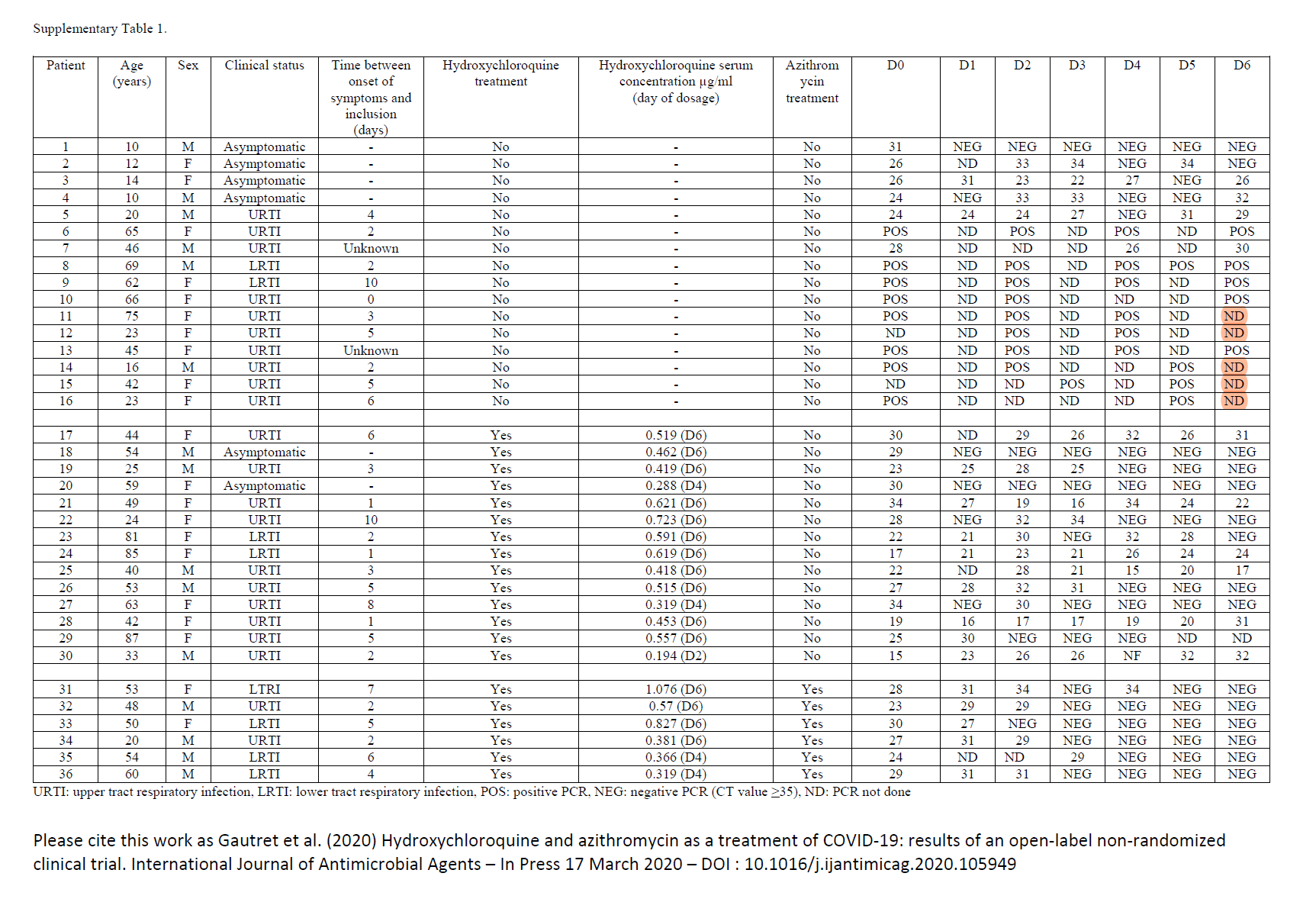
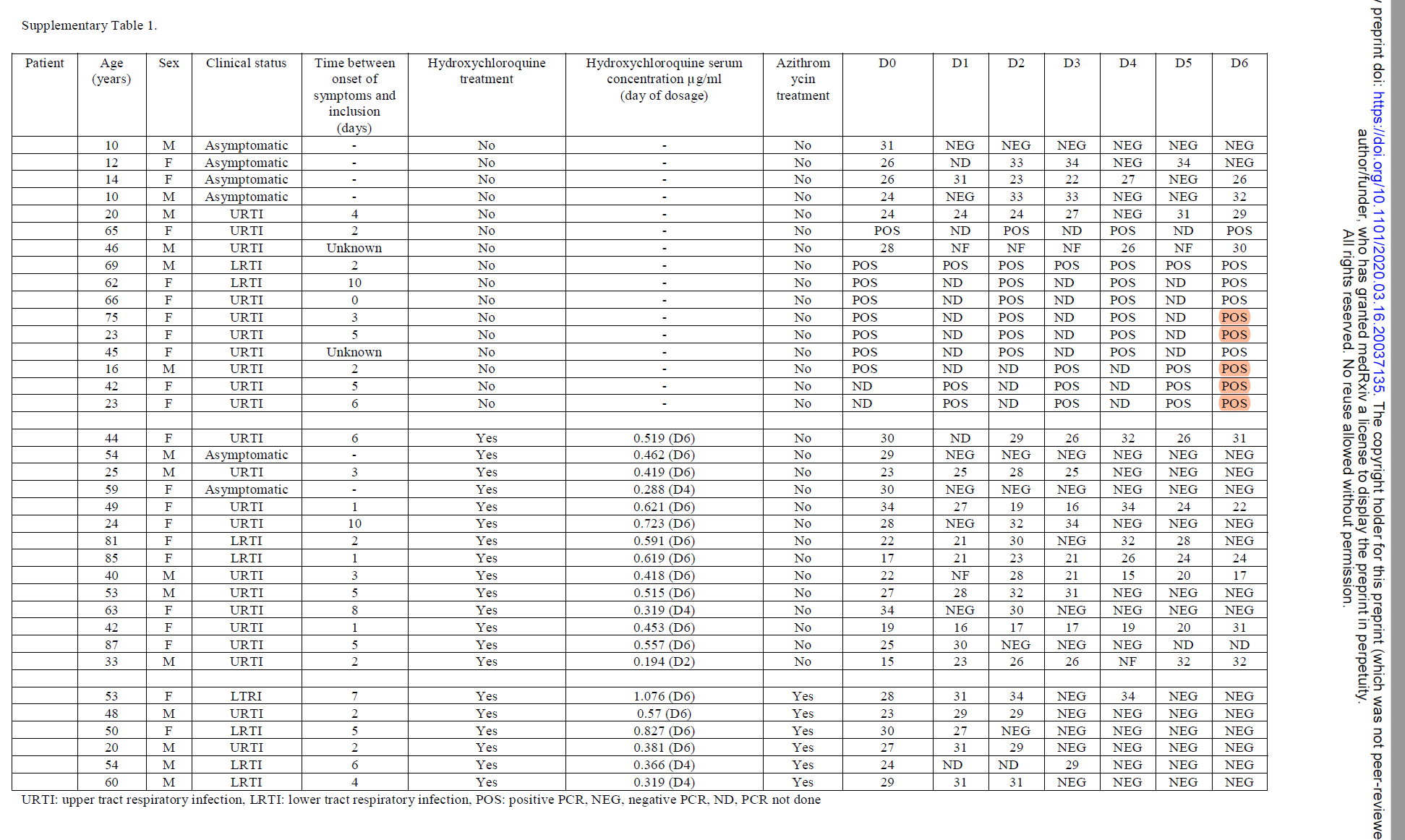

Another PubPeer user re-ran the analysis, because “an important number of non-treated patients were not tested by PCR (ND)“. Once the ND values were disregarded, there wasn’t any more significant difference between controls and chloroquine-treated patients.
Not only control group had to be adjusted: the treatment group somehow lost 6 patients, as Bik discussed:
“Although the study started with 26 patients in the HQ or HQ+AZ group, data from only 20 treated patients are given, because not all patients completed the 6-day study. The data for these 20 patients looks incredibly nice; especially the patients who were given both medications all recovered very fast.
What happened to the other six treated patients? Why did they drop out of the study? Three of them were transferred to the intensive care unit (presumably because they got sicker) and 1 died. The other two patients were either too nauseous and stopped the medication, or left the hospital […] So 4 of the 26 treated patients were actually not recovering at all.”
It seems, the authors simply removed inconvenient patients from the analysis before publishing their study. They left online their previous evaluation though, which showed a slightly different result, compare here the day 6 time point:

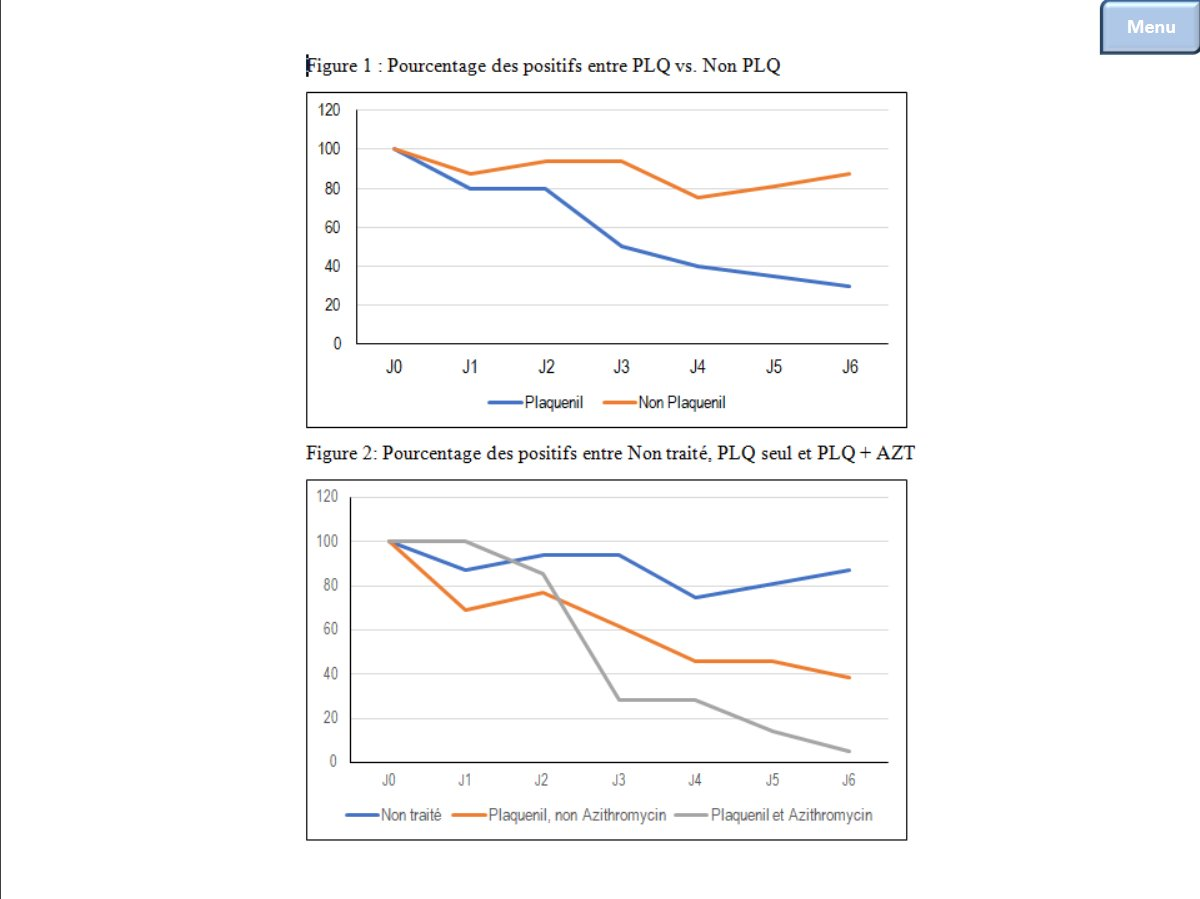
Statistical and ethical problems with that Gautret et al 2020 study were addressed extensively in this preprint by Dahly, Gates & Morris zenodo 2020. The authors also reject Raoult’s claims about previous positive results from China:
“In the background of their paper, Gautret et al referred to “an early clinical trial conducted in COVID-19 Chinese patients, [which] showed that chloroquine had a significant effect, both in terms of clinical outcome and viral clearance, when comparing to control groups”. There were two citations for this claim. The first was a letter7 that doesn’t report any trial data, but instead refers to a conference held in China in February, during which participants (“experts from government and regulatory authorities and organizers of clinical trials”) seemingly agreed that chloroquine was an efficacious treatment for COVID-19. The second cition (also included in the aforementioned letter) refers to a number of clinical trials registered in China, though many of these have now been suspended or closed, while the remaining trials are still recruiting (per their entries on http://www.chictr.org.cn as of March 21, 2020). Hence there are, to our knowledge, no other published reports of clinical trials testing the efficacy of chloroquine for COVID-19 treatment.”
However, now a proper randomised controlled clinical trial was done in China on chloroquine treatment of COVID19. The authors of Chen et al 2020 report:
“One patient in HCQ group developed to severe during the treatment. On day 7, COVID-19 nucleic acid of throat swabs was negative in 13 (86.7%) cases in the HCQ group and 14 (93.3%) cases in the control group (P>0.05). The median duration from hospitalization to virus nucleic acid negative conservation was 4 (1-9) days in HCQ group, which is comparable to that in the control group[2 (1-4) days, (U=83.5, P>0.05)]. The median time for body temperature normalization in HCQ group was 1 (0-2) after hospitalization, which was also comparable to that in the control group 1 (0-3). Radiological progression was shown on CT images in 5 cases (33.3%) of the HCQ group and 7 cases (46.7%) of the control group, and all patients showed improvement in follow-up examination. Four cases (26.7%) of the HCQ group and 3 cases (20%) of the control group had transient diarrhea and abnormal liver function (P>0.05)”

BUT WHAT IF RAOULT IS RIGHT AND IT WORKS?????
I hear you ask that. After all, Raoult is a star of French science: he publishes a scientific paper “nearly every work day”, thanks to 800 employees working under him, as a blog post mentioned, and he is so important that his Marseille collaborators named two bacteria species after the grand director: Raoultella planticola and Rickettsia raoultii.
Well, Elisabeth Bik found some very bad data fakery in a 15 year old Raoult-co-authored paper:
Florence Fenollar , Stéphane Sire , Nathalie Wilhelm , Didier Raoult Bartonella vinsonii subsp. arupensis as an agent of blood culture-negative endocarditis in a human Journal of Clinical Microbiology (2005)
doi: 10.1128/jcm.43.2.945-947.2005

The gels are most obviously fake, falsified in Photoshop. In at least one instance, a gel band was erased digitally. Here a younger Raoult-coauthored paper from URMITE Marseille, and it is not much better:
Miguel A. De La Cruz , Weidong Zhao , Carine Farenc , Grégory Gimenez , Didier Raoult , Christian Cambillau , Jean-Pierre Gorvel , Stéphane Méress A toxin-antitoxin module of Salmonella promotes virulence in mice PLoS Pathogens (2013) doi: 10.1371/journal.ppat.1003827
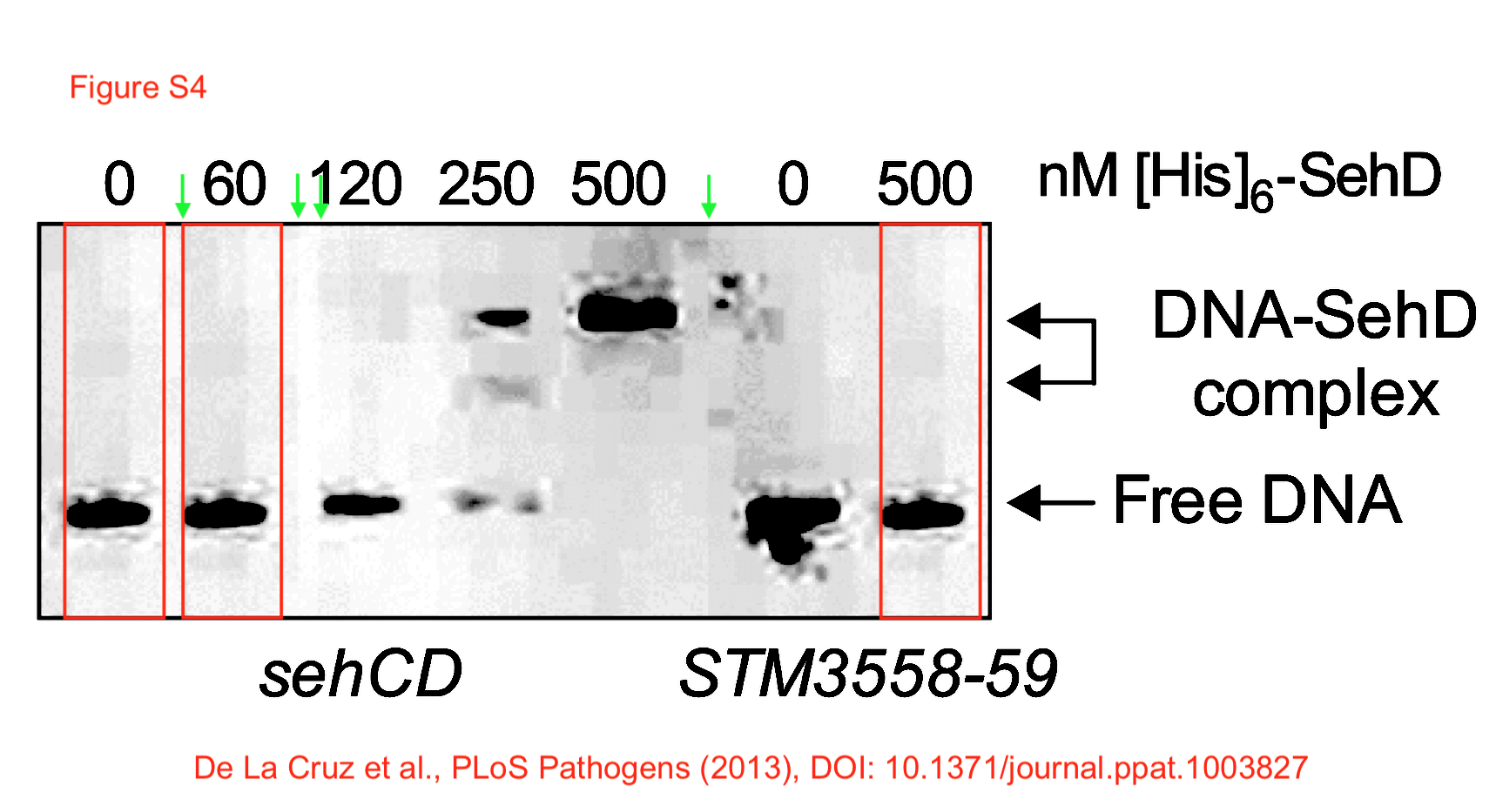
A gel lane was copied three times, while arrows indicate additional image manipulations in that gel figure. The last author Stéphane Méresse seems not to deny that the image was fabricated:
“This image should never have been published and we apologize for this mistake. Below two similar experiences leading to the same conclusion.”
Caught on fake data? Replace it with something else, conclusions not affected. As easy as removing patients from analysis or guessing PCR results. The research culture at URMITE produced also this beauty, again with Raoult as coauthor:
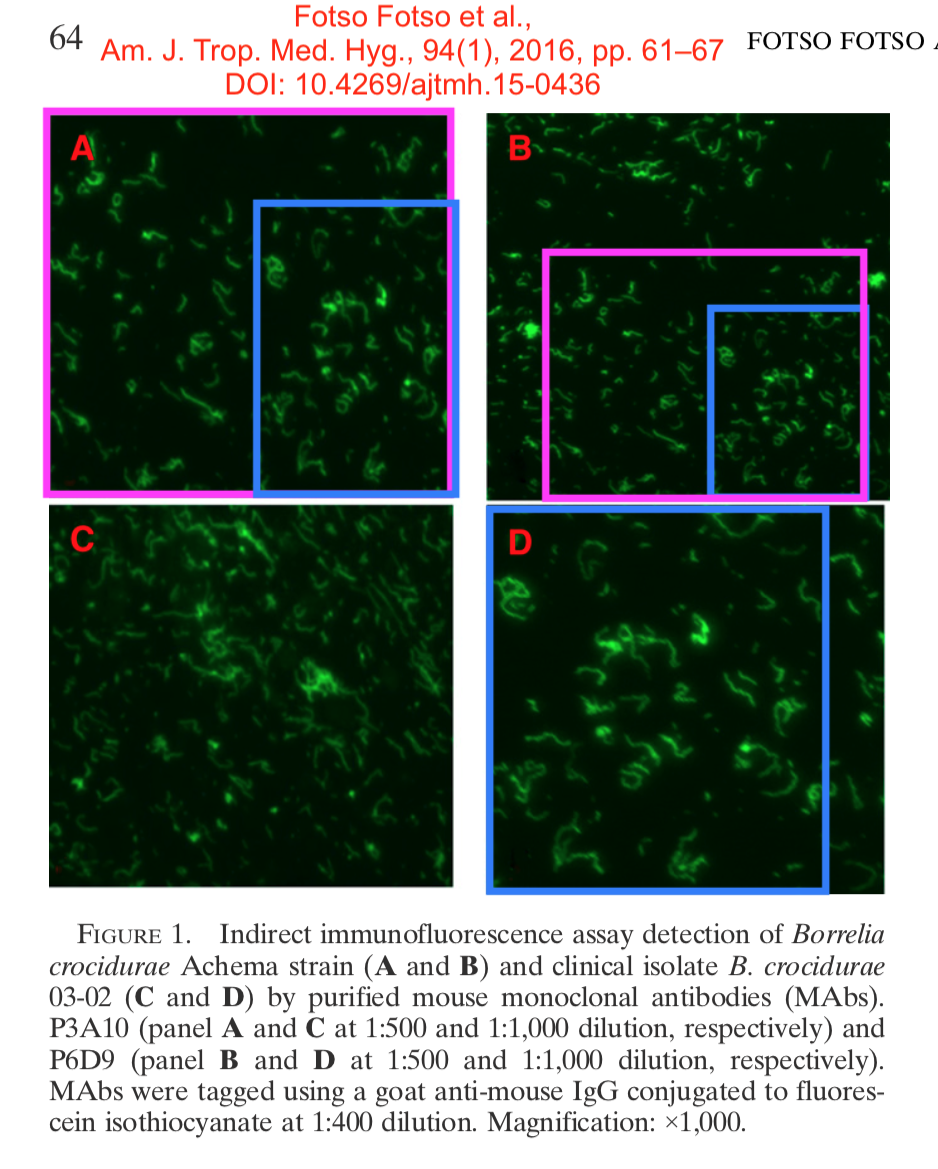
That is truly a beautiful fake. Fractal bacteria, as someone commented on Twitter. Bik found also this, a 19 year old microscopy collage co-authored by Raoult:
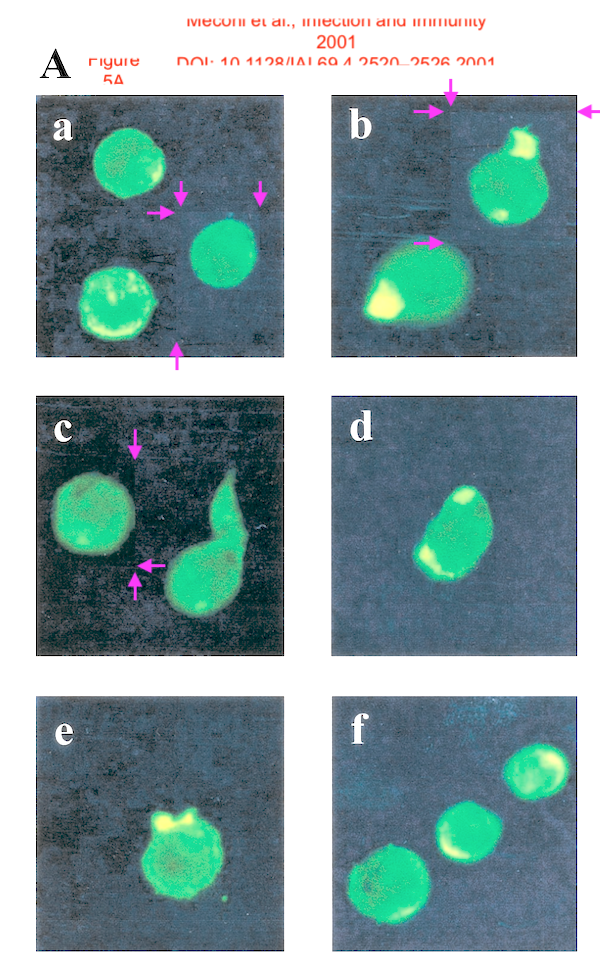
The arrows indicate that the cells were digitally pasted in. To catch Raoult on having published fabricated data is not really a surprise, as it turned out.
More recently, Raoult’s lab simply slightly darkened an image of a 2D western blot and re-used it again, for a different bacteria. Nobody complained.
M Kowalczewska, A N’Djatchi , C Nappez , S Alwassouf, P Decloquement, N Armstrong, K El Karkouri, S Edouard, D Raoult Identification of rickettsial immunoreactive proteins using a proximity ligation assay Western blotting and the traditional immunoproteomic approach Comparative Immunology Microbiology and Infectious Diseases (2018) doi: 10.1016/j.cimid.2018.06.004
Other PubPeer users joined Bik on the treasure hunt and found another duplicated gel, again slightly darkened:
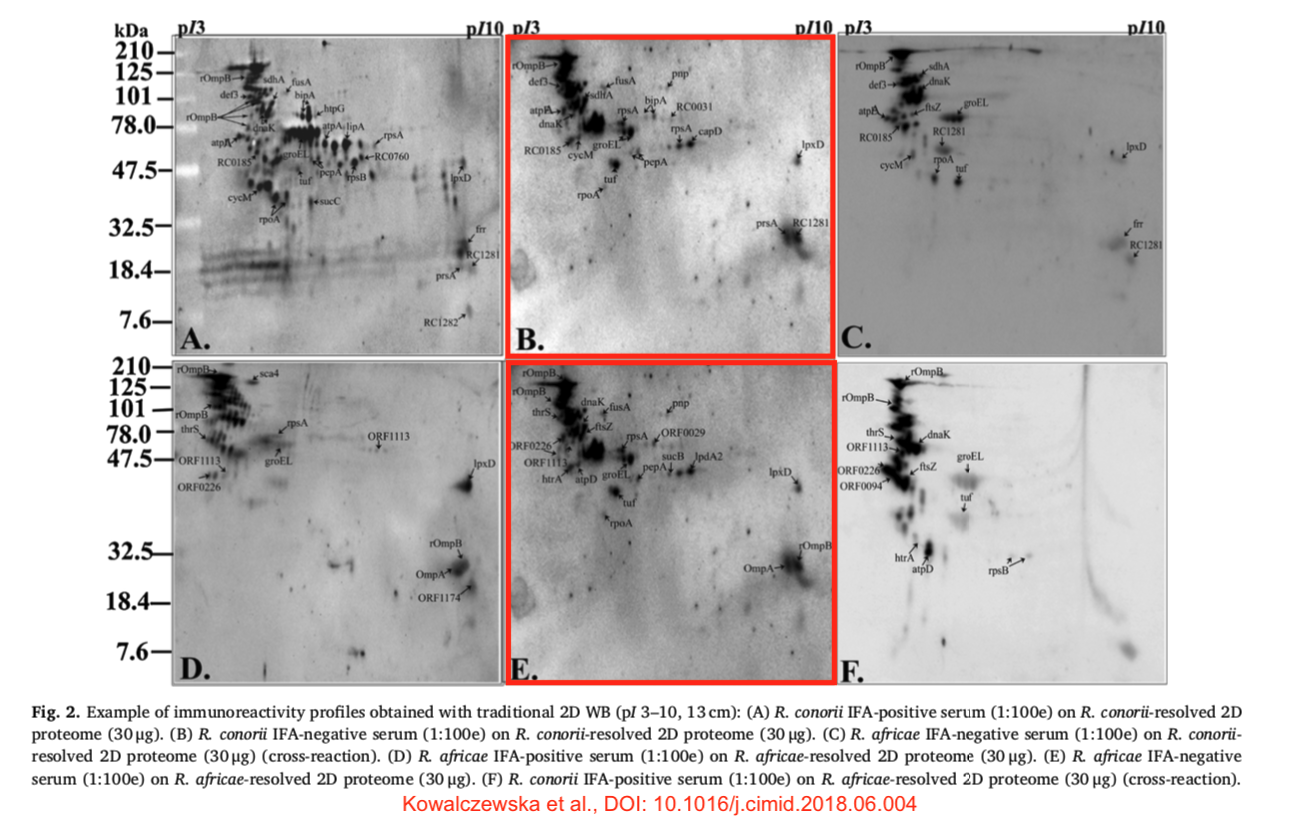
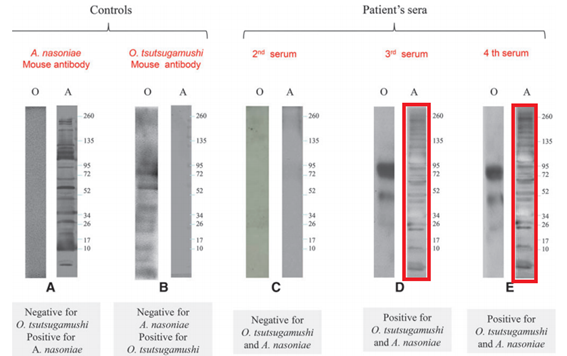
n 2012, Science magazine brought an article about Raoult’s scientific achievements, where hidden among all the celebration were descriptions of his bullying and lack of basic research integrity. Some quotes:
“Yet Raoult is also known for his enmities and his disdain for those who disagree with him. “People don’t like to talk about him because he has a lot of influence. He can make life hard for you,” says one of several French researchers contacted by Science who would only talk about Raoult if they could remain anonymous. “Few of his science colleagues will fi nd the thought of another profile story about him particularly appealing,” geneticist Jean-Michel Claverie of Aix-Marseille University—who severed ties with Raoult in 2006 after a 5-year collaboration—wrote in an e-mail to Science“.
and then:
“But some scientists grumble that manuscripts out of Raoult’s lab often contain errors, for instance, as a result of unchecked genetic sequences.
Indeed, problems in a paper about a mouse model for typhus got his lab in hot water in 2006. A reviewer for Infection and Immunity, a journal published by the American Society for Microbiology (ASM), discovered that four figures in a revised manuscript were identical to figures in the original manuscript, even though they were supposed to describe a different experiment.
In letters to ASM, made available by Raoult, second author Christian Capo and last author Jean-Louis Mège, a group leader, accepted “full responsibility” for the problem, which they said involved only two figures. Capo, in his letter, wrote that he had made an innocent mistake; Mège wrote that Capo had subsequently failed to show the revised manuscript to other authors, who were on vacation, before resubmitting it. But after consulting its ethics panel, ASM banned all five authors, including Raoult, from publishing in its journals for a year. “We are not entirely comfortable with the explanation provided,” ASM officials wrote to Mège. “Misrepresentation of data … is an affront to the ethical conduct of scientific inquiry.”
Capo and Mège accepted the decision, but Raoult wrote ASM that he wasn’t at fault and that the “collective punishment” was “very unfair.” He appealed the ban, also on behalf of two other co-authors, but lost. Furious, he resigned from the editorial board of two other ASM journals, canceled his membership in the American Academy of Microbiology, ASM’s honorific leadership group, and banned his lab from submitting to ASM journals, in which he had published more than 230 studies. His name has been on only two ASM journal papers since, both published in 2010. To clear his name, Raoult sent his ASM correspondence to French colleagues in 2007, along with a letter defending himself. “If I had been in the United States, I would have sued,” he wrote.”
The closer one examines Raoult's history, the worse he looks. Here's his take on climate change, ca. 2013:
— Charles Seife (@cgseife) March 26, 2020
"La planète ne se réchauffe plus depuis 1998. Jusqu'à cette date, le réchauffement brutal était lié à un phénomène météorologique : El Niño."https://t.co/nJYJorMaTT
Raoult did not like Science coverage of his genius. He made the journal publish an Erratum, where he even wrongly accused the author of shilling for Danone:
“IT WAS AN HONOR TO HAVE MY PROFILE PUBlished in Science (“Sound and fury in the microbiology lab,” C. Mary, News Focus, 2 March, p. 1033). However, I was surprised that 20% of the article is devoted to the American Society for Microbiology (ASM) story, in which I was a collateral victim of a collective sanction (there has been no collective liability in France since World War II). I did not manage the paper and did not even check the last version. The mistake by C. Capo consists of a single figure inversion (not four, as stated in the Science profile). This paper has since been published (1). In January 2007, I was awarded one of the highest ASM honors—the ICAAC lecture—thus clearing doubts about my scientific integrity.”
Accusing your critics of being Nazis or Nazi collaborateurs is standard practice in French academia, especially when you are called out on data manipulation. But you probably started to get a gist that Raoult is not a nice man and not prepared to be criticised or disagreed with. He has a way to make his subordinates deliver the results he likes:
He organized (at least when I was there, in 2012) giant meetings every Wednesday for PhD students in his institut to show their work in progress.
— Donyk (@BDonyk) March 26, 2020
If he was in a bad mood, he could completely destroy the student in front of every one
Now, the extra bit of irony is that Raoult is so full of himself that he published in 2018 an opinion piece to teach France some… research integrity. The occasion was the Catherine Jessus affair which I myself incidentally have caused.
Il pleut de la merde
In 2017, Raoult’s leadership was challenged by a sexual harassment and assault scandal at his URMITE institute, an affair with at least six victims which the director himself described as “a love story gone wrong“. The perpetrator was eventually sacked, but Raoult did not handle the case exemplary, quite the opposite. This article in MarsActu narrates that Raoult tried to hush up the affair for two years while even trying to have the victim sacked:
“For CGT union which made public the sanction at a press conference on Monday, these behaviours are not the result of misconduct of a single person but fall under a system set up around the personality of Director URMITE, Didier Raoult. “I am appalled by the fact that the director of the URMITE could not report acts of harassment to his superiors and his guardianship for two years” . […] “The alleged victims and the person they have named as their attacker were installed in adjacent laboratories within the new premises of the IHU” […] “threats (…) currently uttered by Mr. Raoult against Mrs. A, “ . “We have just been informed that Mr. Raoult intends to fire Mrs. A from URMITE. This is unacceptable “ .
Allegedly Raoult also threatened the other victim, a foreign graduate student, warning her that she will not be allowed to complete her thesis if she blows the whistle. Raoult rejected all accusations against himself and denied responsibility. In reality, the gigantic institute is run as his own private fiefdom, as a 2015 evaluation report criticised (discussed in this blog post). Harassment and abuse of students and employees used to be apparently normal under Raoult iron rule, as a 2017 union report criticised:
“Several students or former students testified to work hours without limits, aggravated work stress, work at night or on weekends. They seem to have an enormous pressure for results. Their presence on publications appears to be based on the needs of those responsible. A visit of the CHSCT helped to highlight the fact that, hitherto, lab coats were not provided to them, so they had to get one on their own and had to wash it outside, despite handling of pathogens in the laboratory. […]
We know of many transfer requests, made by the ITA, but also researchers, INSERM, CNRS and Aix-Marseille University. This seems not to have alerted the leadership on the situation of employees in the unit.
The head of the graduate school had to manage a significant number of students from reallocations of URMITE to other units, during or at the end of their thesis.”
Le professeur Raoult est-il le général de Gaulle du coronavirus ? https://t.co/P5FHTc32h6 pic.twitter.com/25gLaxFjdm
— L'Obs (@lobs) March 24, 2020
Employees wrote in 2017 a protest letter denouncing Raoult’s dictatorship. A quote:
“Some of us are frequently belittled, mocked, humiliated, subjected to chauvinist remarks, inappropriate attitudes, violent verbal altercations, even threats from the hierarchy. One research engineer was threatened with professional death…”
The institute reacted by writing a letter to the Minister for Research announcing to punish the whistleblowers (see this blog post), whom Raoult described as “five or six grumpy jealous” and “bitter people“. This is revealing about how URMITE is run:
“A former research engineer URMITE explains that Didier Raoult works “with a table in his head” . “A cross-tabulation with two columns. He regards you more or less, depending on your status, doctor, pharmacist, researcher, engineer .. . And more or less depending on whether you are a man or a woman , he says. We had group meetings on Friday and I have often seen women from crying. “
Raoult demands results from his serfs, unconditionally:
“These tensions in the work are also felt by some doctoral students who describe situations of harassment. “Our research director, close to Didier Raoult, was struggling to handle the pressure that he put on him to get results, says one of them. Suddenly, a pyramid, the pressure fell on us.” He remembers meetings on “work in progress” where students whose work did not convince were humiliated by the research directors, with Raoult at the top.”
In March 2018, in the aftermath of the sexual abuse scandal which he tried to hush up while threatening the victims, Raoult announced:
“I thank you for having described this place as a brothel. I installed a condom machine “
Later in 2018, Raoult published an opinion piece in Le Point, where he used his authority as medical doctor and expert on sexually transmitted diseases to certify that the alleged victims of sexual harassment should not to be believed, not even by the police.
Now consider this. Raoult’s past papers show falsified data, which even resulted in his ban by ASM for one year, to which Raoult responded with threats of lawsuit. He is a patriarchal control freak and a misogynous bully who violently punishes all disagreement and uses threats against whistleblowers and victims to achieve compliance. He is pathologically resistant to criticism and believes to be infallible and omniscient: Raoult denied anthropogenic climate change in 2013 and before that, the microbiologist even denied evolution in his 2011 book “Beyond Darwin“. Raoult’s new study on chloroquine as the cure for COVID19 is obviously flawed, at best.
Should we really trust his claims and put our all lives in his hands?
The article was significantly updated since it first appeared.
Update 7.04.2020
On 4 April, after being alerted by my readers on Twitter and in the comment section, I tweeted about a statement by the International Society for Microbial Chemotherapy (ISAC), which issues the Journal of Antimicrobial Agents (IJAA). That was now picked up by international media an credited to Retraction Watch. The statement, signed by the society’s president Andreas Voss, was published on 3 April:
“ISAC shares the concerns regarding the above article published recently in the International Journal of Antimicrobial Agents (IJAA). The ISAC Board believes the article does not meet the Society’s expected standard, especially relating to the lack of better explanations of the inclusion criteria and the triage of patients to ensure patient safety.
Despite some suggestions online as to the reliability of the article’s peer review process, the process did adhere to the industry’s peer review rules. Given his role as Editor in Chief of this journal, Jean-Marc Rolain had no involvement in the peer review of the manuscript and has no access to information regarding its peer review. Full responsibility for the manuscript’s peer review process was delegated to an Associate Editor.
Although ISAC recognises it is important to help the scientific community by publishing new data fast, this cannot be at the cost of reducing scientific scrutiny and best practices. Both Editors in Chief of our journals (IJAA and Journal of Global Antimicrobial Resistance) are in full agreement.”
I contacted Voss and asked him if the paper will be retracted. Voss replied:
“ISAC is not the publisher. That is Elsevier and as according to them all rules and industry standards were followed a retraction is not what they consider.“
Voss then added:
“we own the title of JGAR but not of IJAA. Still, IJAA is an “official society journal” and as such we feel the responsibility, which is why we expressed our concerns.“
So it seems Elsevier put their foot down and said no.
Update 10.04.2020
ISAC now replaced and backdated the statement. As I was told by Voss, this happened on orders from Elsevier, who apparently decided ISAC scientists are not qualified to form an opinion about clinical research. The original ISAC statement from 3 April is deleted and replaced with a joint statement of ISAC together with Elsevier. The critical first paragraph is gone, but this is added:
“At present, additional independent peer review is ongoing to ascertain whether concerns about the research content of the paper have merit. Given this process of post-publication assessment is on-going, it would be premature to comment at this time. The study authors have been contacted and asked to address the concerns. Depending on the nature of their response, a correction to the scientific record may be considered in accordance with the policies of Elsevier and the Committee on Publication Ethics (COPE): https://www.elsevier.com/editors/perk/corrections-to-the-record.”
Update 12.04.2020
Now both statements are online: the one from 3 April by ISAC, restored uncensored, and the joint statement from 11 April with Elsevier, as separate release. Thanks ISAC.